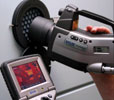

Infrared thermal cameras require a direct line of sight to record an accurate image. In order to detect a hot-spot the area to be measured has to be under normal operating conditions, meaning that it must be live and have been so for 20 minutes prior to inspection. This puts maintenance personnel at risk, since they have to open cabinets or doors to gain access to the internal components that they wish to image, even the most comprehensive risk assessments and method statements cannot avoid this. In response, electrical panel manufacturers are now fitting infrared inspection ports in an attempt to make their panels more maintenance friendly.
In the US, regulation NFPA 70E determines the ‘Flash Protection Boundary’ of electrical panels; these boundaries define the safe working distances in which personnel can operate from an energised component. Thermographers must be conversant with these regulations, especially if they intend to remove covers to allow access for a live inspection. Also the NFPA 70E regulations stipulate that, unless the thermographer is a certified electrician and fully conversant and qualified on the equipment under inspection, they will need to be accompanied, thus increasing the manpower requirement for the inspection.
An arc flash does not happen without a trigger, it nearly always begins due to a ‘change of state’ that causes a momentary connection between phases. 99% of the time these arc flash incidents are caused by intervention, opening a panel for example, spontaneous arc flashes very rarely occur.
IR windows offer a safe alternative
IR Windows remove the risks and downtime associated with live inspections. Their use in a thermographic inspection programme removes 99% of the triggers of arc flash incidents while improving electrical safety by allowing safe, regular infrared inspections of energised and loaded electrical switchgear.
Although there are several types of IR window available on the market, all have the same basic form of an optic material transparent to IR energy encapsulated in a holder. The ideal IR window is one that would allow infrared radiation to pass through it with zero losses. Unfortunately this is not possible with the materials currently available, but it is possible to get close enough that measurement accuracy is not compromised. IR windows can remove the risks and downtime associated with live inspections.
Definition
A window is used to separate environments of differing pressures or temperatures, while allowing energy at a specified electromagnetic wavelength to pass between the two environments. An infrared window (also referred to as a viewport, viewing pane, sight-glass, port or grill) is a generic term used to describe an inspection point that is designed to allow infrared radiation to transmit to the outside environment. Simply put, an infrared (IR) window is a data collection point for a thermal camera. All IR windows must fulfil the strength, rigidity and environmental requirements of the type of equipment into which it is installed. It must also be compatible with the infrared equipment being used.
Some IR windows are simply the housing with an open centre and a cover that secures the opening. Typically, the IR window housing will contain a grill or an optic. The design, size, and material used are driven by considerations such as the required field-of-view, camera lens compatibility, intended environment, sealing requirements, and safety considerations.
The full guide can be downloaded at http://instrumentation.co.za/+C17136

© Technews Publishing (Pty) Ltd | All Rights Reserved